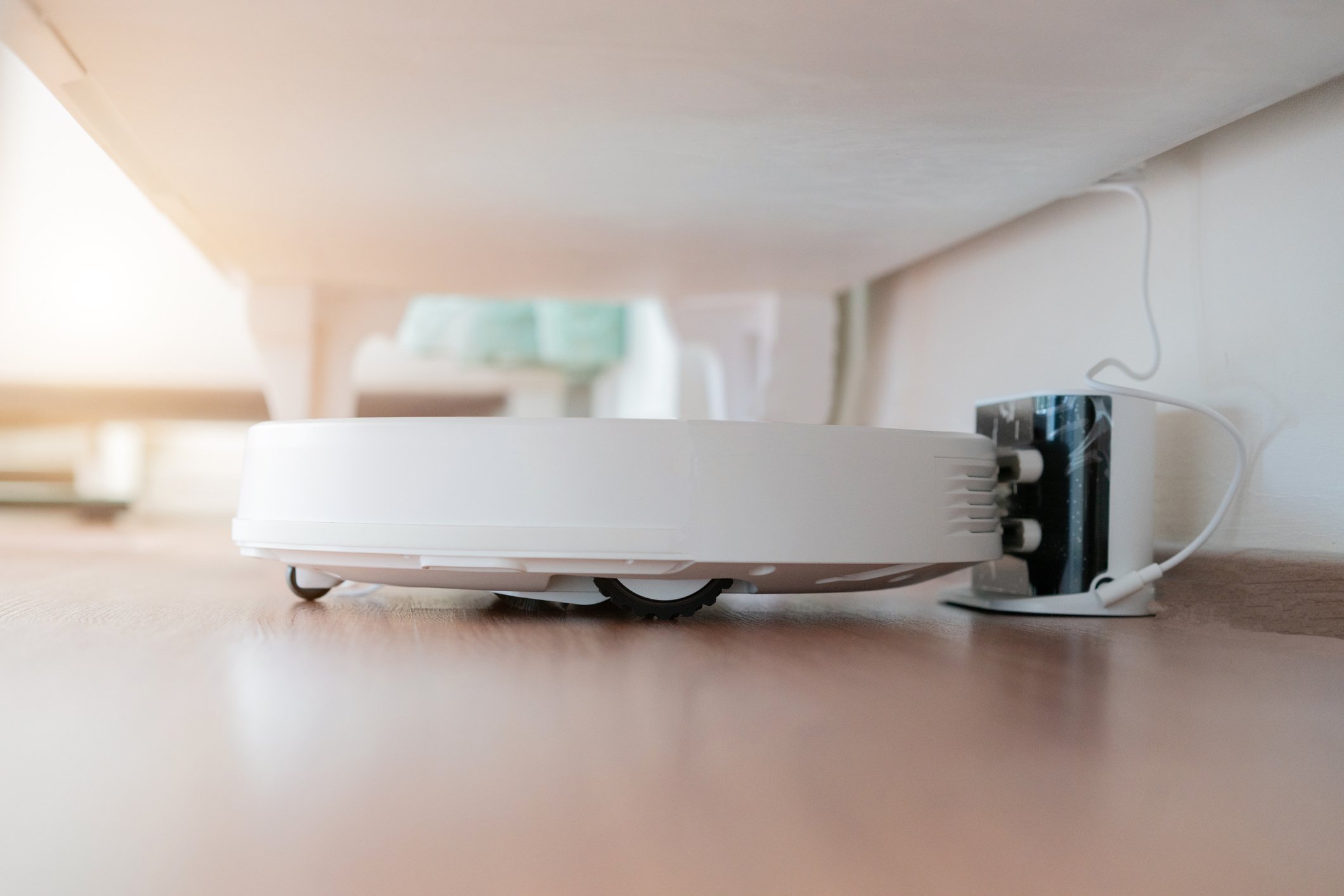Shares of iRobot (IRBT 19.88%) were pummeled after the company released its second-quarter 2014 results last month. The robot maker fell short of revenue estimates, and missed earnings estimates by a hair if we exclude the benefit of a one-time tax valuation allowance. The stock dropped nearly 17% in the week following the release, though has inched its way up, and is now down about 10% since earnings.
Of course, earnings releases never tell the entire story, so you might want to check out five key takeaways from the conference call with analysts.
iRobot's stock sell-off begs this question: Is this is a good time to buy the stock?

iRobot's best known product: the Roomba vacuuming bot. Source: iRobot
Before we move into our discussion, a snapshot of iRobot's business by segment should be helpful:
|
Segment |
Percentage of Revenue First Half 2014 | Percentage of Revenue Projected Full-Yr 2014 |
|---|---|---|
|
Home (Consumer) |
95% |
91% |
|
Defense & Security |
4% |
8% |
|
Remote Presence |
1% |
1% |
Source: iRobot's Q2 report.
One important note: The defense business has been shrinking as a percentage of the total business over the last few years. The figures above make it seem that defense has been growing; however, this is just due to the "lumpy" revenue situation in 2014, with the bulk of revenue expected in the second half.
Valuation
Valuation has generally been shown to matter – at least over the long-term. However, it matters less for high growth stocks or ones which have strong future growth expectations, in my opinion. With this in mind, let's look at some common valuation metrics for iRobot.
It's best to look beyond just absolute valuations to relative ones – that is, relative to a company's closest peers and competitors. However, iRobot doesn't have good comparables. There are no other publicly traded companies that generate the vast majority of their revenue from consumer robots. Several main finance sites list Electrolux and Lockheed Martin as competitors. Electrolux specializes in traditional appliances, not robotic ones. Investors are investing in iRobot because they view robotics as a growth space and cleaning bots as just a starting point for the company's offerings. Lockheed is a defense contractor, and iRobot's defense business accounted for just 5% of its revenue in the first half of the year. Additionally, Lockheed's market cap is 55 times as large as iRobot's, and size matters in valuations, as it's easier for smaller companies to post stronger revenue growth. So, we're going to leave out comparables.
|
Company |
Market Cap |
Price/Sales |
P/E |
P/E (forward) |
5-Year PEG |
|---|---|---|---|---|---|
|
iRobot |
$1.0 billion |
2.0 |
42.2 |
24.9 |
0.91 |
Source: Yahoo! Finance
To provide a bit context, the average P/S and forward P/E for stocks in the S&P 500 are 1.7 and 15.7, respectively. However, the average company in the index isn't forecast to grow nearly as fast as iRobot. Investors shouldn't look at valuation measures in a vacuum (no pun intended, Roomba!), but along with current and future projected growth.
|
Company |
2014 Est. Revenue Growth |
2015 Est. Revenue Growth |
2014 Est. EPS Growth |
2015 Est. EPS Growth |
5-Year Est. Avg. Annual EPS Growth |
|---|---|---|---|---|---|
|
iRobot |
14.3% |
15.5% |
22.3% |
22.6% |
33% |
Source: Yahoo! Finance
The market is a forward-looking machine, so the forward price-to-earnings ratio is a better metric than the trailing P/E, in my opinion. Of course, the forward P/E relies on analysts' estimates, so it's a less "firm" number than the trailing P/E. However, in most cases, analysts are usually decent at projecting growth one year out, so it's usually a solid metric. There's no doubt that iRobot's forward P/E of nearly 25 is pricey, especially given the company's weak medium-term performance; revenue has increased at an average annual rate of 3.8% over the past three years, while earnings-per-share have decreased an average of 11%. However, it's important to keep in mind that the defense business has been dragging down the overall results, and concealing the fact that the company's core home business has been performing solidly. Given the defense segment's share of the company's overall revenues has been decreasing, this business now has less of an effect on overall results. This dynamic should continue. There's one more factor to remember – iRobot has a nice cash stash ($182.7 million at the end of the last quarter) and no debt. This factor is usually worth a bit of a premium in valuation. And if we back out the $6.20 in cash that it has per share, the forward P/E drops to 20.1.
Importantly, iRobot's earnings are projected to grow 22% this year and 23% next year, not far off the company's forward P/E. Additionally, the average annual growth for the next five years is expected to be a brisk 33%. If these growth projections pan out, iRobot will grow into its valuation within this period.
We can see this more clearly when we look at the 5-year PEG. (The PEG is the P/E divided by future growth estimates; in this case, for the five-year period.) A PEG less than 1 can indicate that a stock is undervalued -- that is, if growth expectations come to fruition.

RP-VITA medical telepresence robot. Source: iRobot
The million-dollar question is whether iRobot will grow as fast as analysts are projecting. The company has some distinct positives – most notably, its early mover status and continued success in the home business, and its promising medical telepresence bots, which provide more growth potential than its enterprise offerings, in my opinion. However, investors shouldn't write-off one key factor: iRobot's moat isn't that strong. There is a relatively low technological barrier to entry to its bread-and-butter home cleaning bots business.
A whopping 29% of iRobot's shares are sold short, so many are betting against the company. While there are cracks in the company's armor, it doesn't deserve this level of bearishness, in my opinion. It seems some of these investors – or traders -- might not be taking into account a couple important factors. First, iRobot is "it" when it comes to a consumer-focused pure-play robotics stock trading on a major U.S. exchange. Actually, it's the only game in town when it comes to a non-industrial-focused pure-play robotics company that trades on a major U.S. exchange, too. This factor alone helps demand. Second, it appears that a good number of investors are patient and willing to give CEO Colin Angle a fairly long leash.
More specifics will be covered in the upcoming bull and bear thesis articles.
Foolish opinion
I remain cautiously optimistic about iRobot as a long-term play. The the stock's current valuation is relatively pricey, as discussed above. However, if growth projections remain on track – and there's no current reason to assume they won't – the stock should grow into its valuations within a few years. The company has a first-mover advantage in the consumer robotics market, and is in the early stages of developing what could be a potentially lucrative commercial business. The main concern is the company's moat, as it needs to remain high enough to keep competitors at bay, as margins aren't fat enough to allow for heavy price competition. Investors need to monitor the competitive landscape, which is heating up in the robotics space.
Those with higher-risk tolerances who have long-term investing horizons might want to consider nibbling away. However, most others should probably wait on the sidelines to see how the next few quarters play out.





